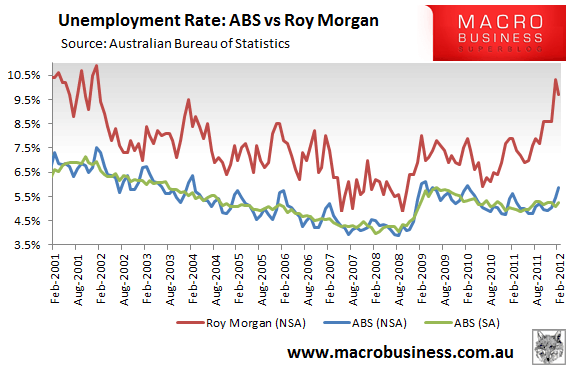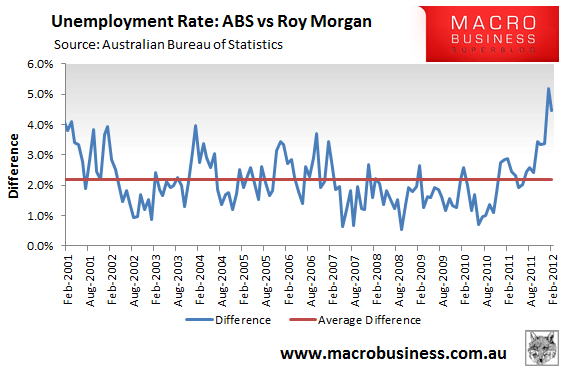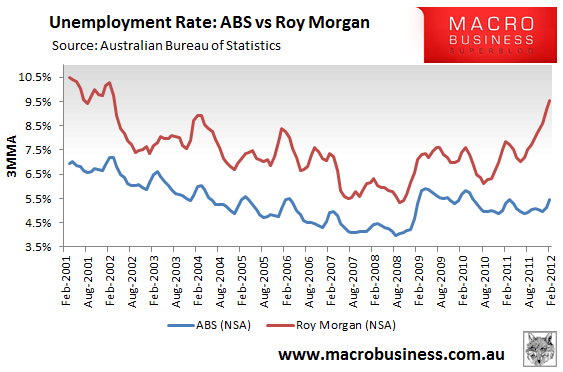
By Leith van Onselen
Last week, Australia’s unofficial provider of labour force data, Roy Morgan Research, released its employment figures for February, whereby it estimated that 9.7% of Australians were unemployed, down 0.6% from January 2012.
As explained last month, Roy Morgan Research measures employment differently from the Australian Bureau of Statistics (ABS), which is Australia’s official provider of labour force data:
According to the ABS definition, a person who has worked for one hour or more for payment or someone who has worked without pay in a family business, is considered employed regardless of whether they consider themselves employed or not.
The ABS definition also details that if a respondent is not actively looking for work (ie: applying for work, answering job advertisements, being registered with Centre-link or tendering for work), they are not considered to be unemployed.
The Roy Morgan survey, in contrast, defines any respondent who is not employed full or part-time and who is looking for paid employment as being unemployed…
Since Roy Morgan uses a broader definition of unemployment than the ABS, it necessarily reports a higher unemployment figure. In addition, Roy Morgan’s measure tends to be far more volatile, owing to the fact that it draws on a smaller sample than the ABS and is not seasonally adjusted.
Following the release of the ABS labour force data for January, which registered a surprise fall in Australia’s unemployment rate from 5.2% to 5.1% (reversed in February), the head of Roy Morgan Research, Gary Morgan, claimed that the ABS unemployment estimate “defy belief and common sense” and suggested that “the ABS figures are diverging from reality” in light of the “constant stream of companies announcing retrenchments in the early stages of 2012”.
Gary Morgan also argued that the ABS measure is a lagging indicator as it “only classifies an unemployed person as part of the labour force if, when surveyed, they have been actively looking for work in the four weeks up to the end of the reference week“, whereas the Roy Morgan estimate “provides a more accurate picture of what is happening on the ground” since its “estimates are taken at that point in time“.
In light of the release of the ABS February labour force data yesterday, which produced a slight increase in the official unemployment rate to 5.2% (seasonally adjusted), I considered it worth while to compare and contrast the ABS unemployment estimate with Roy Morgan’s February release.
The below chart plots the ABS seasonally adjusted (SA) and non-seasonally adjusted (NSA) unemployment rate series against Roy Morgan’s NSA series:

Focusing on the NSA series only, you can see that there was some convergence in the Roy Morgan and ABS measures in February, although they remain far apart, historically so. In January, the Roy Morgan estimate was 5.2% higher than the official ABS measure – the highest divergence in the series’ 11-year history. However, in February, the difference fell to 4.5%, which is still way above the average divergence of 2.2% over the life of the series:

Given the wide margin between the two series, it would be easy to write the Roy Morgan figures off as being unreliable. However, if both series are charted on a 3-month moving average (3MMA) basis (in order to reduce volatility), you can see that they tend to be highly correlated – it’s just that something weird has happened recently that has pushed the two series far apart:

As I noted last month, it remains to be seen whether Roy Morgan’s estimate is right or wrong with respect to the direction of the labour market. Either Roy Morgan’s unemployment rate will retrace sharply in coming months (beyond usual seasonal movements), the ABS figure will deteriorate toward Roy Morgan’s, or some combination of the two.
My guess is the answer lies in the different methodologies. Roy Morgan is clearly more sensitive to underemployment and as Adrian Rollins points out at the AFR today, that’s an increasingly important issue:
The jobless rate has been held down by a slide in the proportion of people looking for work, a sign Australia is not as close to full employment as official figures suggest.
The participation rate, which shows the percentage of adults in work or looking for a job, slumped from 66 per cent to 65.2 per cent over the past 14 months. The under-utilisation rate – which covers job seekers and workers who want more hours – rose 0.6 of a percentage point in January from a year earlier.
The Australian Bureau of Statistics also admitted that if it did not count as employed people who worked as little as one hour a week and wanted more hours, the jobless rate would be 5.85 per cent.
If it included people who could work but were no longer actively seeking employment, the rate would be 7 per cent.

